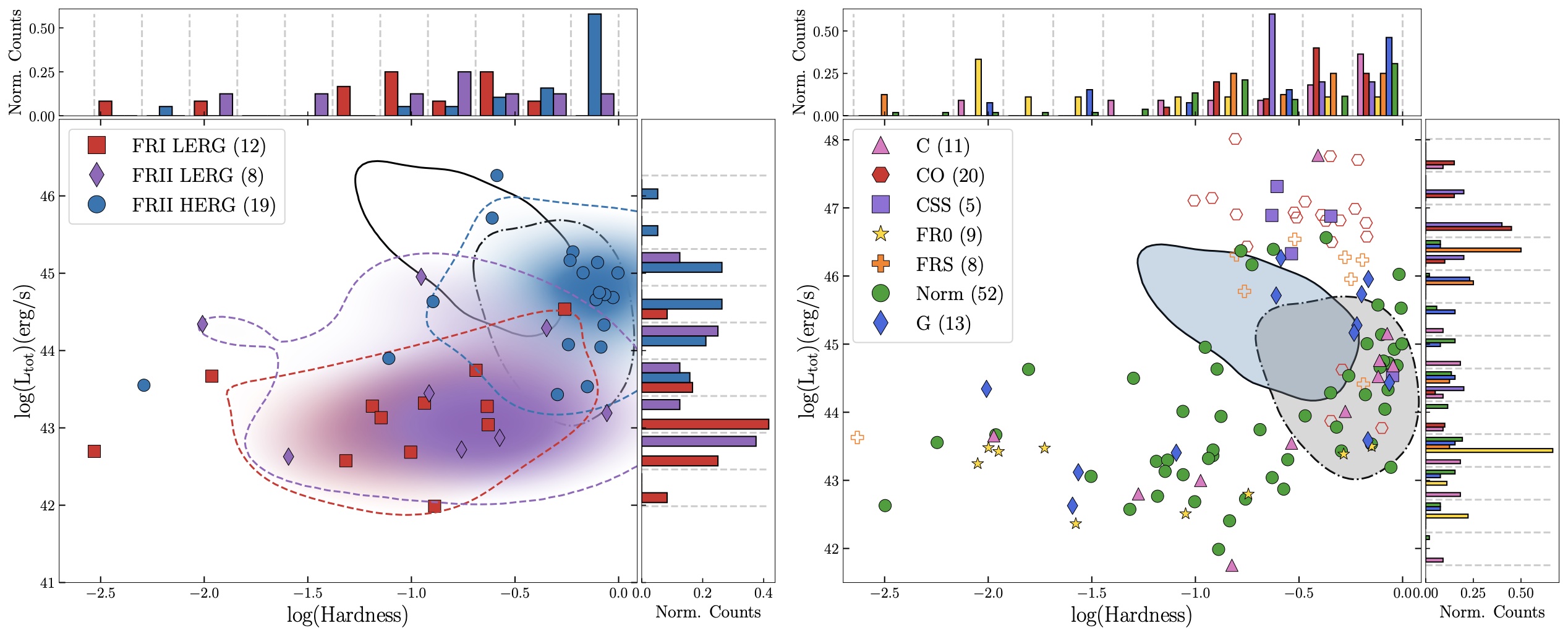Research Question
Do active galactic nuclei (AGN) with different radio properties lie in distinct parts of the hardness-intensity diagram (HID) reflecting X-ray binary (XRB) states?
Quick Summary
To address whether AGN jets might be related to accretion states as in XRBs, I explore whether populations of radio-AGN classified according to their radio jet morphology (FR I and II), excitation class (HERG and LERG), and radio jet linear extent (compact to giant) occupy different and distinct regions of the AGN hardness-intensity diagram (total luminosity vs. hardness). I find that (a) FR Is and IIs, (b) HERGs and LERGs, (c) FR I-LERGs and FR II-HERGs occupy distinct areas of the HID at a statistically significant level (p-value < 0.05) and no clear evidence for population distinction between the different radio jet linear extents. The separation between FR I-LERG and FR II-HERG populations is the strongest in this work. Our results indicate that radio-loud AGN occupy distinct areas of the HID depending on the morphology and excitation class, showing strong similarities to XRBs.
Publication
- Moravec, E. et al., Do Radio Active Galactic Nuclei Reflect X-ray Binary Spectral States?, 2022, A&A, 662, A28.
Video Summary
- A 10 minute video explaining what a radio galaxy is with the public being the intended audience: Radio Galaxies
Background and Motivation
Black holes that accrete surrounding matter are some of the brightest objects in the sky and allow us to study physical processes under conditions of extreme gravity and high orbital velocities. Black holes usually come in two varieties: stellar mass black holes, which are often found in X-ray binaries (see in left panel of image below), and supermassive black holes which are at the centres of galactic nuclei (see right panel of image below). But the question is, are these black hole systems analogous to each other, and differ only in scale?

Image credit: Left: NASA/CXC/M.Weiss. Right:ESO/WFI (Optical); MPIfR/ESO/APEX/A.Weiss et al. (Submillimetre); NASA/CXC/CfA/R.Kraft et al. (X-ray).
Our research group is exploring the similarities and differences between the accretion around stellar mass (those in X-ray binaries) and supermassive black holes (those in AGN) to examine whether black holes across the mass scale can be unified in their accretion states. We want to answer the question, are these black hole systems analogous to each other, and differ only in scale? The unification between AGNs and XRBs is important for understanding the accretion processes in both kinds of objects. In our work, we investigate the inherent similarities and differences between AGN & XRB – what can be scaled up or down to understand these two classes of black holes. Our primary tool is to compare various states & properties of XRBs with different classes of AGN.
Full Summary of Findings
Methods
I investigate whether populations of radio-AGN lie in distinct areas of the AGN HID by cross correlating 15 catalogs of radio galaxies with classification for radio jet morphology (FR I and FR II), excitation class (HERG and LERG), and radio linear extent (compact to giant) from the literature with XMM Newton and Swift X-ray and UV source catalogs. I calculate the luminosity and hardness from the X-ray and UV photometry, place the sources on the AGN hardness-intensity diagram.
I define the hardness (\(H\)) and the total luminosity (\(L_{\mathrm{tot}}\)) as follows:
\[H = \frac{L_P}{L_{\mathrm{tot}}} = \frac{L_P}{L_P+L_D} \approx \frac{L_{X-ray}}{L_{X-ray}+L_{UV}}\]Results
Radio Morphology and Excitation Class

Radio morphology (FR I & II): From a sample of 64 sources (26 FR Is and 38 FR IIs), there is a separation of FR Is from FR IIs at a statistically significant level (p-value < 0.05) where FR Is have lower total intensity and softer hardness values and FR IIs have higher total intensity and harder values. These populations are separated in an Eddington ratio vs. hardness diagram as well. Because FR Is are located in the AGN state diagram where weaker (low-hard) states of XRBs are present and FR II sources are located where stronger (hard) states of XRBs are present, the FR Is could be the analogs of the early stages of the outburst (with a weaker jet) and the FR IIs could be analogous to the later stages of the outburst (with a brighter, more powerful jet).
Excitation class (HERG & LERG): From a sample of 120 sources (94 LERGs and 26 HERGs), we find that the HERGs and LERGs do occupy different areas of the HID at a statis- tically significant level with the LERGs being more widely distributed in both hardness and Ltot and HERGs are harder and more luminous. This difference becomes more prominent with Eddington ratio vs. hardness. However the difference between the areas that each population occupies is not as distinct as the difference between the FR I and II populations. In an XRB analogy, the HERGs could be the analog of the radio-AGN ramping up in accretion power and the LERGs the initial state.
Radio Morphology + Excitation Class and Extent

Radio morphology (FR I & II) + excitation class (HERG & LERG): In a sample of 39 sources (12 FR I-LERGs, 8 FR II-LERGs, and 19 FR II-HERGs), there is a clear separation between FR I-LERGs and FR II-HERGs with FR I-LERGs being less luminous and softer and FR II-HERGs having a higher total luminosity and being harder. The separation between FR I-LERGs and FR II-HERGs is the strongest in this work (at a statistically significant level) which indicates that combining both FR and excitation class seems to differentiate populations of radio-AGN the most in the HID. Thus, both the jet morphology and central engine need to be considered when comparing to XRBs.
Radio extent (compact, normal, giant): In a sample of 118 sources (53 compact sources, 52 normal, and 13 giant), we do not see any strong evidence for a separation between the different populations of radio linear extent. If the compact sources are not blazars and AGN have analogous evolutionary states to XRBs, the compact sources could be the equivalent of the ballistic jets found in XRBs.
Implications
In conclusion, I find evidence that AGN with specific radio properties occupy distinct areas of the HID, similar to XRBs. This adds to evidence already found by Falcke et al. (2004); Nipoti et al. (2005); Kording et al. (2006b); Merloni & Heinz (2008); Svoboda et al. (2017); Fernández- Ontiveros & Muñoz-Darias (2021) that different radio-load AGN population may follow an evolutionary track similar to the tracks followed by individual XRBs during an outburst. However, it is difficult to perfectly differentiate the AGN states and directly correlate them with specific XRB states. But the general separation between populations with specific radio properties in the AGN HID argues for a similarity with XRBs HID and thus allows us to draw parallels between XRB and AGN evolution.
Research Question Answer
Q: Do AGN with different radio properties lie in distinct parts of the HID diagram reflecting XRB states?
A: Radio-loud AGN do indeed occupy distinct areas of the HID depending on the morphology and excitation class, showing strong similarities to XRBs.
